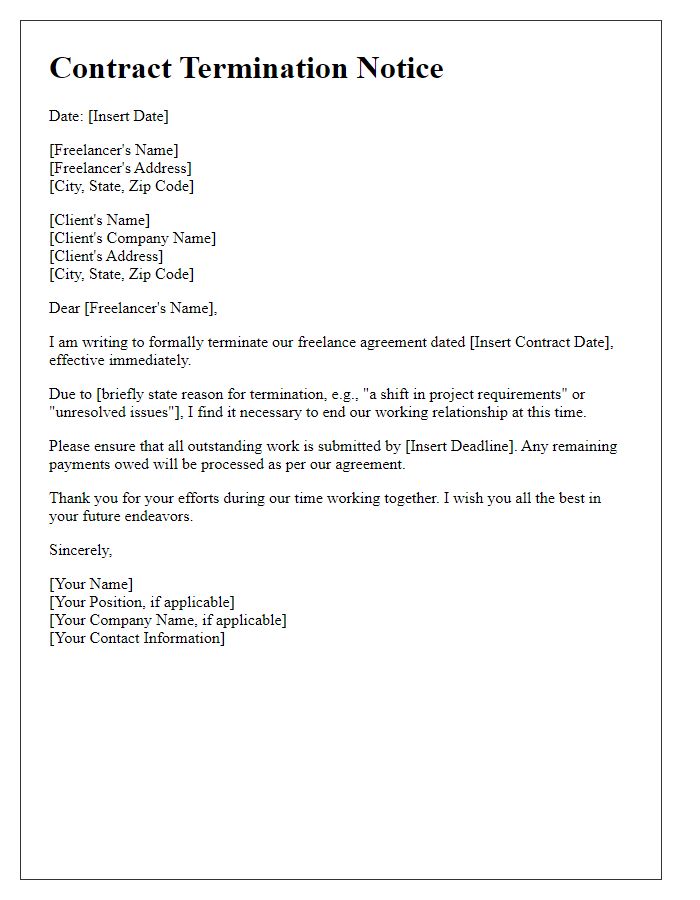Are you finding yourself in a position where you need to terminate a freelance contract? It can be a daunting task, but it's important to approach it with professionalism and clarity. Whether due to changes in project scope, budget constraints, or other unforeseen circumstances, communicating your decision effectively is key. Join me as we explore a step-by-step guide on crafting the perfect termination letter that maintains goodwill and professionalismâread on to learn more!

Clear identification of parties involved
A freelance contract termination must clearly identify the parties involved, such as the client (Company A, located in New York City, established in 2010) and the freelancer (Freelancer B, based in Austin, Texas, specializing in graphic design since 2018). The document should include full names, addresses, and any business registration numbers. This identification ensures that both parties are legally recognized and that correspondence regarding termination is directed appropriately. Additionally, including the specific contract details, such as the project name or contract number, provides clarity and context for the termination process.
Specific termination date
Freelance contracts often require formal termination notices to ensure clarity and legal compliance. A specific termination date, for instance, March 15, 2024, should be stated clearly in the notice. As freelance work can involve various projects, the notice must also reference the project name or contract number for proper identification. Furthermore, it's essential to include any outstanding payments due for completed work, setting clear expectations about final invoices. The freelance relationship, typically governed by terms outlined in the original contract, should be summarized to ensure both parties understand the agreed conditions for termination, promoting a professional conclusion to the working arrangement.
Reason for contract termination
Underperformance can lead to contract termination in freelance projects. Factors include missed deadlines, subpar quality of work, and lack of communication, which disrupt project timelines. For example, a graphic design project for a client may suffer if the freelancer fails to deliver initial drafts by the agreed date, causing delays in the overall marketing campaign launch. Additionally, a consistent lack of revisions or failure to incorporate client feedback may render the project unviable, prompting a decision to terminate the contract for both parties' benefit. Clear documentation of these issues can support the termination process while ensuring professionalism and maintaining industry relationships.
Obligations or final deliverables
Upon termination of the freelance contract, the freelancer must fulfill all remaining obligations, which include the completion of all final deliverables as specified in the initial agreement. This may encompass specific project milestones, final reports, or any outstanding creative elements related to the work conducted for the client. The timeline for submission of these deliverables should align with the termination notice period, ensuring that the client receives necessary documentation or assets by the agreed-upon deadline. Additionally, any final invoicing for completed work should adhere to the payment terms established in the contract, thereby facilitating an efficient conclusion to the professional relationship.
Contact information for follow-up
Freelance contract termination requires a clear understanding of the involved parties. The freelancer's name, typically seen on the contract, should be paired with their email address for direct electronic communication. The client's organization name or individual name is essential alongside their email for formal correspondence. Specific project identification, including the contract number or project name, helps to ensure clarity in communication. Dates such as the original contract start date and the termination date should be prominently included to establish the timeline of work. A concise statement indicating the reasons for termination, such as completion of deliverables or changes in business needs, may be helpful for record-keeping. Additionally, including a section for follow-up communication can ensure that all parties remain informed throughout the process.
Letter Template For Freelance Contract Termination Samples
Letter template of freelance contract termination due to project completion

Letter template of freelance contract termination for unsatisfactory performance

Letter template of freelance contract termination for financial constraints

Letter template of freelance contract termination for breach of contract










Comments